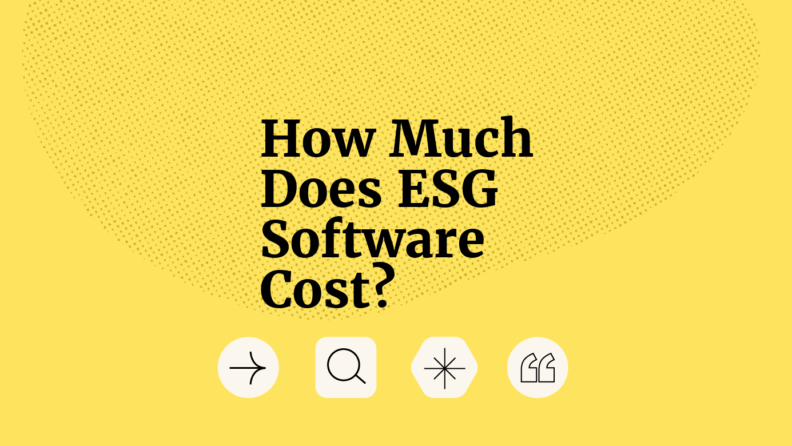ESG software pricing varies by company size, reporting requirements, and integrations — larger organizations or those with complex compliance needs will pay more.
The sticker price rarely reflects the total cost; factor in onboarding, integrations, data volume, and compliance updates to avoid surprises.
Focus on long-term ROI and scalability — choose a platform that can grow with your business and adapt to evolving regulatory requirements.
Figuring out how much ESG software will cost your organization isn’t always straightforward. Vendors often use complex pricing models tied to usage, company size, and compliance frameworks, and many don’t publish clear rates upfront. This lack of transparency makes it hard for finance leaders, sustainability teams, and department heads to plan budgets with confidence.
This guide breaks down what you can expect to pay for ESG software, the most common pricing models, and the hidden costs to watch for.
You’ll also find advice on evaluating ROI and negotiating contracts so you can invest wisely in a platform that supports compliance today and scales with your business tomorrow.
What Factors Influence ESG Software Pricing?
ESG software pricing is shaped by your organization’s size, reporting needs, and the complexity of your compliance obligations. Here are the main factors to consider:
| Factor | How It Affects Pricing |
| Company size & users | Larger organizations with more employees, facilities, or departments typically pay more because the software must handle higher data volumes and more user licenses. |
| Reporting frameworks supported | If you need to comply with multiple standards (e.g., GRI*, SASB**, CSRD***, SEC climate disclosure****), expect higher costs for expanded ESG reporting capabilities and frequent regulatory updates. |
| Geographic scope | Multinational companies often pay more to track region-specific requirements, regulations, and compliance in multiple jurisdictions. |
| Integrations | Connecting ESG software with ERP, HR, or financial reporting systems (like SAP, Workday, or NetSuite) can add to costs, especially if custom integration work is required. |
| Support & services | Vendors may charge extra for onboarding, training, or dedicated account management, especially for enterprise deployments. |
**SASB (Sustainability Accounting Standards Board) provides industry-specific standards for disclosing financially material sustainability information to investors.
***CSRD (Corporate Sustainability Reporting Directive) is a European Union regulation that expands ESG reporting requirements, requiring large companies to disclose detailed sustainability information, aligned with the EU’s ESRS (European Sustainability Reporting Standards).
****SEC Climate Disclosure (U.S. Securities and Exchange Commission) refers to proposed rules by the SEC requiring U.S.-listed companies to disclose climate-related risks, greenhouse gas emissions, and other ESG information in financial filings.
Understanding Pricing Models
ESG software vendors use different pricing models, which determine how you’ll pay, not the total cost. Choosing the right model depends on your company size, ESG data needs, and compliance obligations.
Here’s a look at the most common pricing structures:
| Pricing Model | How It Works | What to Watch For |
| Per user or seat | Pricing is based on the number of licensed users who need access. | Can work for small teams, but costs scale quickly as more departments (finance, HR, sustainability, compliance) get involved. |
| Per usage or data volume | Charges are tied to the amount of data processed (e.g., number of facilities tracked, emissions reports generated, or entities monitored). | Unexpected bills if data volume or reporting requirements grow faster than planned. |
| Tiered subscription | Vendors offer tiers (e.g., Basic, Pro, Enterprise) with set feature bundles and usage caps. | Lower tiers may lack critical compliance frameworks or data integrations, forcing an upgrade sooner than expected. |
| Custom enterprise quote | Pricing is tailored to your organization’s specific needs, complexity, geographic reach, and compliance requirements. | Time-consuming to negotiate, and transparency can be limited without competitive benchmarking. |
| Annual vs. monthly billing | Annual contracts usually offer 10–20% discounts compared to monthly (pay-as-you-go) billing. | Monthly may feel flexible, but annual is often the only option for enterprise-grade platforms. |
Typical ESG Software Pricing by Company Size
ESG software costs scale with company size and complexity. Smaller organizations typically need basic reporting, while enterprises require global compliance support, advanced integrations, and dedicated account management.
Here's what to expect for different company sizes:
| Company Size | Typical Price Range (Annual) | What’s Usually Included | Common Use Cases & Vendors |
| Small business (under 200 employees) | $5,000–$30,000/year | Core ESG data tracking, limited reporting, basic dashboards, standard support | Tracking emissions or workforce data for compliance and investor reporting |
| Mid-size business (200–1,000 employees) | $30,000–$80,000/year | Multi-user access, advanced reporting frameworks (e.g., GRI, SASB), integrations with HR/finance systems, priority support | Cross-department ESG management, preparing sustainability reports, supporting audits |
| Large business (1,000–10,000 employees) | $80,000–$150,000/year | Enterprise reporting, configurable dashboards, global compliance coverage, dedicated customer success manager | Managing ESG metrics across multiple facilities or countries, investor-grade disclosures |
| Enterprise (10,000+ employees / multinational) | $150,000–$300,000+/year | Unlimited users, advanced analytics, custom integrations, premium support, ongoing regulatory updates | Global ESG compliance management, detailed stakeholder reporting, assurance-ready data for regulators and investors |
Hidden & Add-On Costs to Watch For
Beyond subscription fees, ESG software solutions often come with additional charges that can affect your budget. These aren’t always obvious upfront, so it’s important to ask vendors about them during demos and contract negotiations.
Here's a breakdown of costs to be aware of:
| Cost | Description |
| Onboarding & setup fees | Implementation can range from a few thousand to tens of thousands of dollars, depending on the complexity of your data migration, system integrations, and initial configuration. |
| Training & change management | Some vendors charge extra for staff training, certification programs, or tailored onboarding sessions to ensure adoption across finance, HR, and sustainability management teams. |
| Premium support | Standard support is often included, but priority response times, dedicated account managers, or 24/7 coverage may come at an additional cost. |
| Integrations beyond standard set | Connecting to ERP, HR, finance, or supply chain systems (e.g., SAP, Workday, NetSuite) may require custom development or third-party middleware, adding significant costs. |
| Data volume overages | ESG platforms often cap the amount of data (e.g., number of facilities, suppliers, or emissions records) included in a plan. Going over these limits can trigger additional charges. |
| Regulatory updates & assurance features | Some vendors charge extra for modules that support new disclosure requirements (like CSRD or SEC climate rules) or provide assurance-ready audit trails. |
| Contract terms & renewals | Minimum contract lengths, auto-renewals, and early termination fees can all lock you into higher costs if your needs change. Always review the fine print. |
Subscription Plans & Upgrade Triggers
Most ESG software is sold through subscription plans, with costs varying by tier, user limits, and feature access. Understanding how these plans scale helps you avoid unexpected upgrades.
- Plan tiers: Vendors often package features into Starter, Professional, and Enterprise plans. Higher tiers unlock advanced reporting frameworks, integrations, or unlimited users.
- Upgrade triggers: Pricing can jump if you exceed limits on users, facilities, data volume, or required reporting standards. For example, a company moving from basic emissions tracking to full CSRD compliance may need to upgrade tiers.
- Annual vs. monthly discounts: Many vendors offer 10–20% savings for annual billing, though larger enterprises are often required to sign multi-year contracts.
Tip: Before committing, map your current and future ESG reporting needs. This ensures you select a plan that won’t force you into costly upgrades within a year.
Maximizing ROI from Your ESG Software Investment
The value of comprehensive ESG software goes beyond simple cost savings. A strong ROI case balances efficiency gains with risk reduction, compliance, and improved stakeholder trust.
Here are key areas to consider:
Time Saved
Automation of data collection and reporting reduces manual work across finance, HR, and sustainability teams. Ask vendors to demonstrate how their platform streamlines recurring reporting cycles (e.g., annual sustainability reports, quarterly compliance filings).
Error Reduction
Centralized ESG data helps prevent inconsistencies and calculation errors, ensuring accurate reporting. Look for platforms with built-in data validation and audit trails that can stand up to investor or regulator scrutiny.
Compliance Assurance
Staying aligned with evolving disclosure standards (e.g., CSRD, SEC climate rules) lowers the risk of fines, reputational damage, or costly remediation. Vendors should show how their software stays current with regulatory changes.
Cross-Team Adoption and Consolidation
A single ESG platform can replace multiple spreadsheets and tools, creating efficient workflows across numerous functions like HR, operations, finance, and legal. This reduces licensing costs and improves alignment around one “source of truth.”
Investor and Stakeholder Confidence
Transparent, reliable ESG reporting strengthens brand reputation and can improve access to capital. Strong ROI includes not only cost avoidance but also the ability to attract investment and meet stakeholder expectations.
Questions to Ask Vendors During Pricing Demos
Demos are the best time to clarify pricing details and uncover potential hidden costs. Come prepared with questions to ensure the platform meets your ESG reporting needs without stretching your budget.
Here are some to guide your demo:
- How is your pricing structured? What are the main cost drivers (e.g., users, data volume, reporting frameworks)?
- What features are included in each tier? Which compliance standards (e.g., GRI, SASB, CSRD, SEC climate rules) are covered at each level, and which require an upgrade?
- Are there usage limits? What happens if we exceed limits on data volume, entities tracked, or number of reports?
- What’s included in onboarding? Do setup fees cover data migration, integrations, and training, or are those billed separately?
- What integrations are supported? Are ERP, HR, and finance system integrations included, or do they require custom development?
- How do you handle compliance updates? Are new reporting requirements included in the subscription, or do they come at an added cost?
- What are the billing terms? How often are we billed, what renewal clauses apply, and are discounts available for multi-year or annual commitments?
- Are there additional fees as we scale? For example, adding new business units, expanding to more countries, or preparing for external assurance.
Tips for Negotiating ESG Software Pricing Pricing
ESG software pricing is often flexible, especially for mid-size and enterprise buyers. With the right approach, you can secure better terms without sacrificing functionality.
Keep these strategies in mind:
- Benchmark competitors: Compare pricing and feature sets across multiple ESG software providers. Pay attention to differences in compliance coverage (e.g., CSRD, SEC, ISSB), as these can be major cost drivers you can leverage in negotiations.
- Ask about discounts: Many vendors offer reduced rates for nonprofits, startups, or multi-year contracts. Long-term commitments can unlock meaningful savings if you’re confident in the vendor fit.
- Request pilot programs: A pilot or phased rollout helps you test how well the software handles your data management and reporting needs before committing. Use pilot pricing as leverage for full-contract negotiations.
- Review renewal terms: Watch for auto-renewals, lock-in clauses, or steep penalties for early termination. Negotiate flexibility so you’re not trapped if compliance requirements or internal needs shift.
- Scrutinize integration fees: Integrations with ERP, HR, or finance systems are often where hidden costs appear. Negotiate to include key integrations upfront rather than paying extra later.
- Confirm compliance updates: Ask whether future regulatory updates (like CSRD expansions or SEC climate rules) are included in your subscription, or whether they’ll trigger new charges.
- Leverage procurement or group buying: If you’re part of a larger corporate group or industry consortium, use bulk purchasing or centralized procurement to drive down costs.
What’s Next?
If you're in the process of researching ESG software pricing, connect with a SoftwareSelect advisor for free recommendations.
You’ll fill out a form and have a quick chat where they get into the specifics of your needs. Then you'll get a shortlist of software to review. They'll even support you through the entire buying process, including price negotiations.




